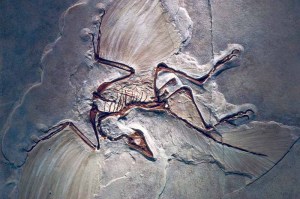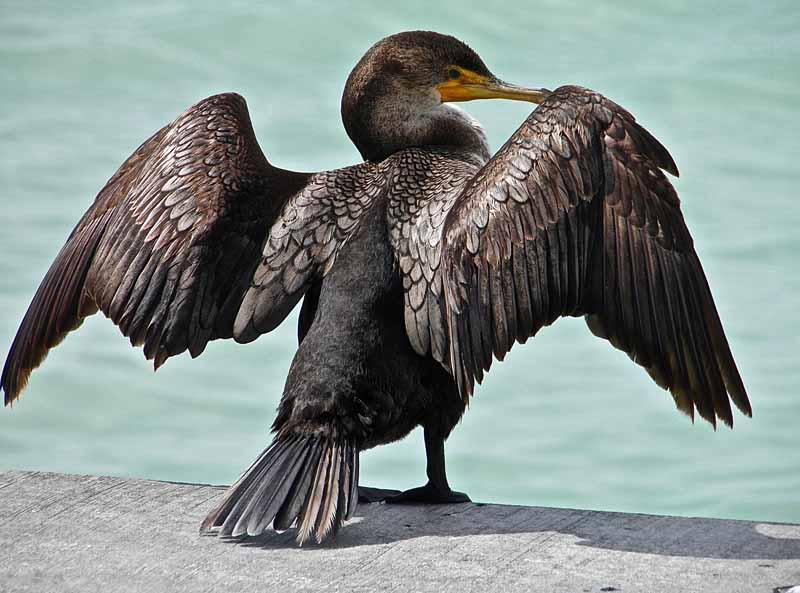The American Museum of Natural History in Manhattan currently has an exhibit through Jan. 2, called Dinosaurs Among Us, which traces how dinosaurs evolved into birds. Anyone who is curious, open-minded or interested in birds should see it. And if possible, take a young child of similar persuasion.
Evolution of Birds
In 1860, one year after Darwin published The Origin of Species, a 150-million year old fossil was found in Southern Germany called archaeopteryx, meaning “original bird” or “first bird.” The fossil with feathers appeared to be a combination of dinosaur and bird. This raven-sized fossil was no “missing link,” but an intermediate form in the evolution of a group of dinosaurs, called theropods, into birds. Dinosaurs had large snouts and big teeth, while birds have evolved bills. These smaller dinosaurs seem to have survived the aftermath of a meteorite that crashed into Earth 65-million years ago that is thought to have wiped out non-avian dinosaurs as well as much of other life. Some 15-million years later, birds appeared. Having made numerous small evolutionary changes over millions of years, they then blossomed into the 18,000 species of birds that today populate the world.

What Resonated
When I walked into the exhibit on a recent Monday morning, the first thing I saw was a dinosaur with a parrot-shaped head and a toothless bill. There was no need to convince me that this was an intermediate form of bird. The exhibit was preaching to a member of the choir. Years ago, I looked at a brown pelican in Florida for the first time. Its size, enormous bill and bulkiness convinced me that these birds had evolved from dinosaurs. Hardly scientific, but seeing is believing. Some years after, at the Jamaica Bay Wildlife Refuge in Queens, I watched a flying glossy ibis. It simply resembled a flying pterodactyl. Nothing could dissuade me.
Several more things about the similarities between dinosaurs and birds at the exit resonated with me. There was a picture of an Eleonora’s falcon of Morocco with wings extended to shelter eggs from the sun. Long extinct dinosaurs did the same with their “wings.” Crocodiles, descended from an ancestor that also gave rise to dinosaurs, build shallow nests. Oystercatchers, a bird with which I’m familiar, scrape shallow depressions in the sand. Thoughtful.
An experiment with chicken embryos by Harvard biologist Arkhat Abzhanov made their beaks look almost snout-like, as those of dinosaurs. This astonished me as I had no idea such research existed. My mantra is “bird bills don’t lie.” Birds’ bills are magnificent tools and I spend time explaining to my birding class how they resemble different tools. Raptors bills resemble old fashioned can openers called “churchkeys;” sandpipers’ bills resemble various length chop sticks and those of finches are like two short, sturdy handles of a nutcracker. Abzhanov has stated that “Modern birds evolved a pair of fingers on the face.” That says so much that, no pun intended, I’m still digesting it.
Flight
Over the years watching herons and egrets hunt, I’ve developed an understanding of “flight” that goes beyond the conception of airplane flight. Herons and egrets can use short spurts of flight to travel mere feet or yards. They can and do use their wings to aid running, walking quickly and turning. Reddish egrets move in a way that almost defies description with their wings held partially out.
In the exhibit, I read about the kinds of flight possibly used by transitional species of birds to dinosaurs. They might have used wings to flap and run up tree trunks, to perhaps flap or glide back down. There also may have been small leaping creatures which used that ability enhanced by wings to pounce on prey or to escape becoming a meal. There is a model of avian flight called Wing Assisted Incline Running, or WAIR, which has been observed in living birds. It suggests that the changing frontal appendages of these transitional birds used for flapping helped them go up steep inclines that couldn’t be otherwise done. It’s a compelling, if incomplete, piece of the puzzle of avian flight.
I am intrigued by acts of being and becoming, metaphorically meaning, a stage where the train has left the station but has not yet arrived at its destination. The development of sustained precision flight by creatures that aren’t actually dinosaurs, but have not yet evolved into birds as we know them, is the land of fascination. The exhibit states “Those awkward in-between stages include some of the most fascinating animals that ever lived…” I can’t visualize those living beings and their behavior, but the idea fires my mind. The steps by which birds developed flight is a mystery and for me, such mystery is an end in itself.
Afterwards
I absorbed as much as I could about how dinosaurs evolved into birds. The amount and kind of information was almost staggering. I then wandered through halls with other exhibitions that engaged me as a child. I was disenchanted because they weren’t as real as they had seemed to be decades ago, but were carefully constructed exhibits. Perhaps imagination burns brightest in the mind of a child.
Afterwards, I had lunch from one of the hot dog wagons on West 77th St. or at the corner of Central Park West and 77th St. that now serve Halal food. I ate chicken kabob on pita bread bought from a Middle Eastern vendor in the shade of a tree. While savoring its taste, I thought that the evolution of street food in New York was a worthy study in itself. However, that’s a job for a young sociologist not a retired one turned birder. I’ve got a lot to learn about how birds evolved from dinosaurs. To sing with the new age avian choir, I’m going to have to learn some new “songs.”

































